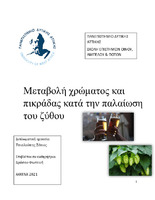| dc.contributor.advisor | Δρόσου, Φωτεινή | |
| dc.contributor.author | Τσιαλούπης, Ξένιος | |
| dc.date.accessioned | 2021-04-21T08:08:29Z | |
| dc.date.available | 2021-04-21T08:08:29Z | |
| dc.date.issued | 2021-02 | |
| dc.identifier.uri | https://polynoe.lib.uniwa.gr/xmlui/handle/11400/591 | |
| dc.identifier.uri | http://dx.doi.org/10.26265/polynoe-442 | |
| dc.description.abstract | Τα τελευταία χρόνια στο χώρο της ζυθοποιίας παρατηρείται μια αδιάκοπη έρευνα και ανάπτυξη
που αφορά στη βελτίωση της πικράδας , του χρώματος και του αρωματικού προφίλ των
παραγόμενων προϊόντων. Κύριο αντικείμενο των ερευνών αυτών είναι οι πρώτες ύλες της
μπύρας οι οποίες μέσα από διαφορετικά μεταβολικά μονοπάτια είναι δυνατό να δώσουν
διαφορετικούς συνδυασμούς οργανοληπτικών χαρακτηριστικών. Αυτό έχει ως αποτέλεσμα να
υπάρχουν αρκετά διαφορετικά προϊόντα όπου ικανοποιούν ακόμη και τον πιο απαιτητικό
καταναλωτή.
Στη παρούσα εργασία μελετήθηκε η μεταβολή του χρώματος και της πικράδας κατά τη
παλαίωση του ζύθου με το πέρας του χρόνου. Ένα από τα πιο βασικά συστατικά του ζύθου είναι
ο λυκίσκος. Ο λυκίσκος, ως βότανο, αποτελείται από αρκετά συστατικά τα οποία με το βρασμό
απελευθερώνονται και είναι υπεύθυνα για τη πικράδα του ζύθου.
Όμως κατά την παλαίωση της μπύρας ο λυκίσκος επηρεάζεται λόγω της οξείδωσης των δεσμών
των οξέων όπου συμβαίνει κατά την αποθήκευση και έχει άμεση επίπτωση στη διάρκειας ζωής
του προϊόντος , οδηγώντας σε οσμή τυριού. Καθώς ο ζύθος εξελίσσεται και ανάλογα με τις
συνθήκες αποθήκευσής του, υφίσταται πολλές αλλαγές. Οι περισσότερες από αυτές τις αλλαγές
σχετίζονται με την επιδείνωση των οργανοληπτικών χαρακτηριστικών, ειδικά στη γεύση ή στο
άρωμά του. Αυτές οι αλλαγές καθώς και η εμφάνιση θολερότητας μειώνουν τη διάρκεια ζωής
του. Οι περισσότεροι από αυτούς τους παράγοντες έχουν ληφθεί υπόψη: το θόλωμα, για
παράδειγμα, εμφανίζεται στην μπύρα που έχει υψηλή περιεκτικότητα σε πρωτεΐνες και τανίνες.
Ένα άλλο σημαντικό συστατικό για τη παραγωγή του ζύθου είναι η βύνη. Η βύνη αποτελείται
από άμυλο το οποίο κατά την ενζυμική διάσπαση δίνει σάκχαρα κατά την διαδικασία της
πολτοποίησης. Κατά τη διαδικασία αυτή μπορούμε να πάρουμε εκχύλισμα από ανοικτόχρωμο
ξανθό ως σκούρο καφέ χρώμα. Έτσι μπορεί να καθοριστεί το χρώμα της μπύρας. Το
βυνογλεύκος περιέχει ανάγοντα σάκχαρα, γλυκόζη, μαλτόζη, φρουκτόζη και αμινοξέα, πεπτίδια
και πρωτεΐνες. Κατά το βρασμό του βυνογλεύκους, σχηματίζονται χρωστικές (μελανοϊδίνες) ως
προϊόντα κυρίως της αντίδρασης Maïllard, όπου η καρβονιλομάδα αντιδρά με τα αμινοξέα και
σχηματίζουν ένα σύνθετο μείγμα μορίων στα οποία οφείλεται το σκούρο χρώμα και άρωμα. | el |
| dc.format.extent | 60 | el |
| dc.language.iso | el | el |
| dc.publisher | Πανεπιστήμιο Δυτικής Αττικής | el |
| dc.rights | Αναφορά Δημιουργού - Μη Εμπορική Χρήση - Παρόμοια Διανομή 4.0 Διεθνές | * |
| dc.rights | Attribution-NonCommercial-NoDerivatives 4.0 Διεθνές | * |
| dc.rights.uri | http://creativecommons.org/licenses/by-nc-nd/4.0/ | * |
| dc.subject | Παραγωγή ζύθου | el |
| dc.subject | Αντίδραση Maïllard | el |
| dc.subject | Λυκίσκος | el |
| dc.subject | Χρώμα ζύθου | el |
| dc.title | Μεταβολή χρώματος και πικράδας κατά την παλαίωση του ζύθου | el |
| dc.title.alternative | Beer color and bitterness changes during aging | el |
| dc.type | Πτυχιακή εργασία | el |
| dc.contributor.committee | Ντουρτόγλου, Γεώργιος | |
| dc.contributor.committee | Chatzilazarou, Arhontoula | |
| dc.contributor.committee | Δρόσου, Φωτεινή | |
| dc.contributor.faculty | Σχολή Επιστημών Τροφίμων | el |
| dc.contributor.department | Τμήμα Επιστημών Οίνου, Αμπέλου και Ποτών | el |
| dc.description.abstracttranslated | In recent years, the brewing industry has focused on continuous research and development related to the improvement of bitterness, colour and the aromatic profile of the products produced. The main objective of this research is to revuew the raw materials used in beer which through various processes it is possible to give multiple combinations of organoleptic characteristics. As a result, there are several different products that can even satisfy the most demanding consumer.
In the present study, the change of colour and bitterness of beer was observed during the aging process of the beer. One of the most basic ingredients of beer is hops. Hops is a herb consisted of several components which are gradually released upon boiling and are therefore responsible for the bitterness of beer.
However, during the aging of beer, hops are affected due to oxidation during storage and has a direct impact on its shelf life due to the oxidation of acid bonds which in the case of aged hops, leads to a cheesy odour. As beer matures and depending on its storage conditions, it undergoes through many changes. Most of these changes are related to the deterioration of sensory characteristics, especially in its taste or aroma. These changes as well as the appearance of opaqueness reduce the overall shelf life of the beer. Most of these factors have been taken into account: opacity, for example, occurs in beer that is high in protein and tannins.
Moreover, another important ingredient for the production of beer is malt. Malt consists of starch, which during the mashing process releases sugars due to the enzymatic breakdown. During this process, an extract is retrieved which ranges from light blonde to dark brown. This extract is what can determine the colour of the beer. This prementioned malt extract consists of invert sugars, glucose, maltose, fructose and amino acids, peptides and proteins. During the boiling process of the malt extract, pigments (melanoidins) are formed mainly due to the Maïllard reaction, where the carbonyl group reacts with the amino acids that form a complex mixture of molecules which therefore give the dark colour and aroma. | el |


